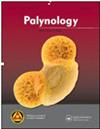Pollen morphology of Doronicum L. (Asteraceae: Senecioneae) from Turkey and its taxonomical implications
IF 1.3
4区 地球科学
Q3 PALEONTOLOGY
引用次数: 0
Abstract
Abstract The main purpose of this study is the palynological characterization of Doronicum L. taxa that occur naturally in Turkey. In this context, the pollen morphology of 11 species and one subspecies of Doronicum was researched in detail by light microscopy and scanning electron microscopy (SEM). Furthermore, principal component analysis (PCA) and hierarchical cluster analysis (HCA) were carried out to identify closely related species and palynological characters that could potentially be used to distinguish the studied taxa. Pollen grains were found to be isopolar monad and tricolporate. Pollen were prolate-spheroidal in shape, with a circular amb. SEM showed the exine ornamentation was echinate-perforate. Differences in the bases and ends of the spines were observed; therefore, pollen grains were categorized based on spine morphology. Three components of the studied palynological characteristics were determined with PCA. The PCA results explained 78.79% of the variation, and polar diameter, equatorial diameter, diameter in polar view, exine thickness, intine thickness, pore length, colpus width, and spine length were found to be the most valuable palynological characteristics for discrimination of the Doronicum taxa. The HCA dendrogram also revealed three main clusters. This study is helpful for understanding the relationships among the taxa of Doronicum and provides insight for future taxonomic research.土耳其杜鹃属植物花粉形态及其分类学意义
摘要本研究的主要目的是对产于土耳其的Doronicum L.分类群的孢粉学特征进行研究。本文采用光学显微镜和扫描电子显微镜对Doronicum的11个种和1个亚种的花粉形态进行了详细的研究。此外,还进行了主成分分析(PCA)和层次聚类分析(HCA),以确定密切相关的物种和孢粉学特征,这些特征可能用于区分所研究的分类群。花粉粒为等极性单孔和三孔。花粉呈扁球形,有圆形突起。扫描电镜显示外壁纹饰为针孔状。观察到脊椎基部和末端的差异;因此,花粉粒是根据脊状形态进行分类的。用主成分分析法确定了所研究的孢粉学特征的三个组成部分。主成分分析结果解释了78.79%的变异,极径、赤道径、极观直径、外壁厚度、内壁厚度、孔隙长度、colpus宽度和脊长是鉴别Doronicum分类群最有价值的孢粉学特征。HCA树状图还揭示了三个主要集群。这项研究有助于了解Doronicum分类群之间的关系,并为未来的分类学研究提供见解。
本文章由计算机程序翻译,如有差异,请以英文原文为准。
求助全文
约1分钟内获得全文
求助全文
来源期刊

Palynology
地学-古生物学
CiteScore
3.40
自引率
26.70%
发文量
48
审稿时长
>12 weeks
期刊介绍:
Palynology is an international journal, and covers all aspects of the science. We accept papers on both pre-Quaternary and Quaternary palynology and palaeobotany. Contributions on novel uses of palynology, review articles, book reviews, taxonomic studies and papers on methodology are all actively encouraged.
 求助内容:
求助内容: 应助结果提醒方式:
应助结果提醒方式:


